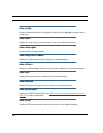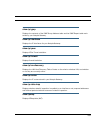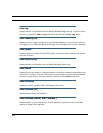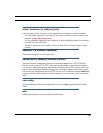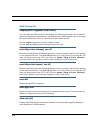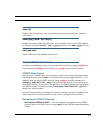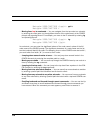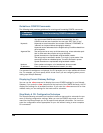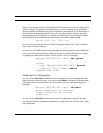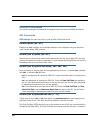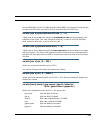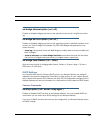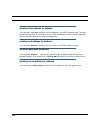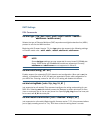
240
Guidelines: CONFIG Commands
The following table provides guidelines for entering and formatting CONFIG commands.
If a command is ambiguous or miskeyed, the CLI prompts you to enter additional informa-
tion. For example, you must specify which virtual circuit you are configuring when you are
setting up a Netopia Gateway.
Displaying Current Gateway Settings
You can use the
view
command to display the current CONFIG settings for your Netopia
Gateway. If you enter the
view
command at the top level of the CONFIG hierarchy, the CLI
displays the settings for all enabled functions. If you enter the
view
command at an inter-
mediate node, you see settings for that node and its subnodes.
Step Mode: A CLI Configuration Technique
The Netopia Gateway command line interface includes a step mode to automate the pro-
cess of entering configuration settings. When you use the CONFIG step mode, the com-
mand line interface prompts you for all required and optional information. You can then
enter the configuration values appropriate for your site without having to enter complete
CLI commands.
Command
component
Rules for entering CONFIG commands
Command verbs CONFIG commands must start with a command verb (set, view, delete).
You can truncate CONFIG verbs to three characters (set, vie, del).
CONFIG verbs are case-insensitive. You can enter “SET,” “Set,” or “set.”
Keywords Keywords are case-insensitive. You can enter “Ethernet,” “ETHERNET,” or
“ethernet” as a keyword without changing its meaning.
Keywords can be abbreviated to the length that they are differentiated from
other keywords.
Argument Text Text strings can be as many as 64 characters long, unless otherwise speci-
fied. In some cases they may be as long as 255 bytes.
Special characters are represented using backslash notation.
Text strings may be enclosed in double (“) or single (‘) quote marks. If the
text string includes an embedded space, it must be enclosed in quotes.
Special characters are represented using backslash notation.
Numbers Enter numbers as integers, or in hexadecimal, where so noted.
IP addresses Enter IP addresses in dotted decimal notation (0 to 255).



